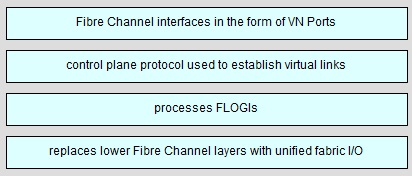- All Exams Instant Download
Drag the description on the left to the most appropriate FCoE protocol or feature on the right
DRAG DROP
Drag the description on the left to the most appropriate FCoE protocol or feature on the right.

Answer: 
Explanation:
ENODES: During FLOGI or FDISC, the ENode advertises the addressing modes it supports. If the FC switch supports an addressing mode that the ENode uses, the virtual link can be established, and the devices can communicate.
FIP: FIP is the set of control plane functions that enable discovery of FCoE-capable devices across FCoE passthrough switches and establishment of legal combinations of virtual links.
FCF: FCoE Initialization Protocol (FIP) is the FCoE control protocol responsible for establishing and maintaining Fibre Channel virtual links between pairs of FCoE devices (ENodes or FCFs). During the virtual link establishment phase, FIP first discovers FCoE VLANs and remote virtual FC interfaces; then it performs virtual link initialization functions (fabric login [FLOGI] and fabric discovery [FDISC], or exchange link parameters [ELP]) similar to their native Fibre Channel equivalents. After the virtual link is established, Fibre Channel payloads can be exchanged on the virtual link, and FIP remains in the background to perform virtual link maintenance functions; it continuously verifies reachability between the two virtual FC interfaces on the Ethernet network, and it offers primitives to delete the virtual link in response to administrative actions to that effect. This document does not describe the virtual link maintenance functions of FIP.
Latest 300-165 Dumps Valid Version with 328 Q&As
Latest And Valid Q&A | Instant Download | Once Fail, Full Refund
Subscribe
Login
0 Comments
Inline Feedbacks
View all comments

